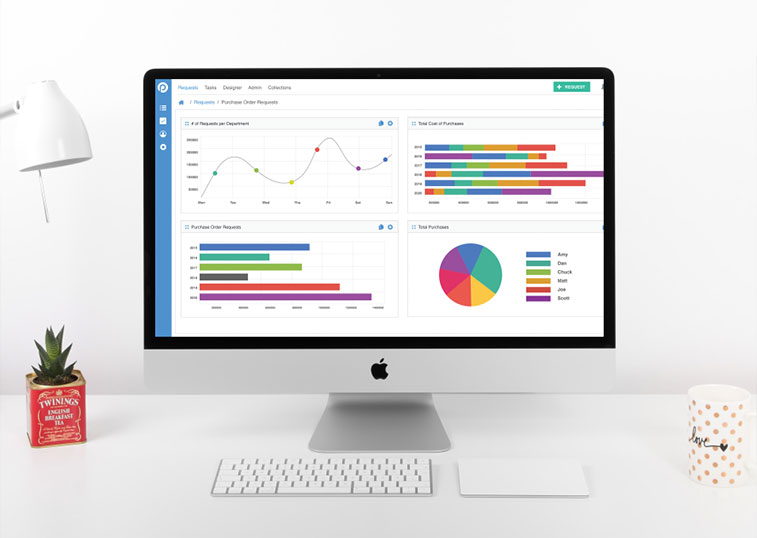As technology advances, along with disruptions brought by fintech and evolving consumer demand, dramatic changes have been made around what digital customers expect of contemporary banking. Consumers want to be consulted and have interactions at the time, location, and situation they prefer. As a result, banks must embrace digital transformation, and they can obtain a competitive advantage in the digital age by implementing Intelligent Document Processing (IDP) in banking forms.
IDP creates usable data by transforming semi-structured and unstructured formats such as emails, PDFs, and images. We are talking about the future of automation with the ability to capture, extract, and process data from a wide variety of formats using artificial intelligence (AI) and machine learning (ML). Further, document and form extraction can be incorporated into existing banking workflows and processes.
Invariably, data is the building block of banking and is critical to daily workflows. One of the biggest challenges is how to transform big data in a way that is aligned with its objectives. There isn’t any question that the human workforce will struggle with managing the vast onslaught of data.
On the other hand, IDP can scan, read, and understand both digital and physical documents so that the human workforce can focus on more strategic tasks and meet customer demands more quickly.
What is IDP?
Banking data is skyrocketing. According to the IDC, worldwide data is expected to surpass 175 zettabytes by 2025. Much of this data can be found in texts, PDFs, scanned files, and emails. Without IDP, human staff would have to manually read, review, and extract useful data from the masses of files. In contrast, IDP can intelligently capture specific data points to streamline document processing for bank forms.
There isn’t any question that information is central to a bank’s organizational workflow. Banks receive data in many formats, from emails and attachments to spreadsheets and paper documents – all from multiple devices. There aren’t enough human employees, or hours in the day, to extract every piece of relevant data. However, you can use IDP to identify, classify, and extract data, then route the information to the designated document processing workflows for review. IDP can replace time-consuming and expensive manual data entry, extraction, and transfer from a cost perspective.
Intelligent Document Processing empowered by Artificial Intelligence
Semistructured and unstructured documents are the most problematic for banks because it is tough to process these files with speed and precision. Compared to traditional OCR solutions, IDP is powered by a “brain” called AI while incorporating robotic process automation (RPA) and the OCR “eyes.” As the system continues to get exposed to larger volumes of data, it learns and improves, freeing up time for the human team to manage more complicated processes.
A key driver for the customer experience in the digital era is the speed and accuracy of processing bank forms. In addition, IDP can help to maintain an audit trail both for compliance and identity fraud. Not only will IDP improve the customer experience, but it enhances the employee experience as well. Many large banks can spend upwards of $500 million annually on identification verification. If the onboarding processes are inaccurate, it can result in formidable fines. Nonetheless, IDP can reduce form handling time while delivering better accuracy to improve compliance. When you think of the time and errors involved in manual bank form processing, wouldn’t it make sense to automate?
With intelligent document processing, you can achieve:
- Accurate identification of different data formats and fields such as customer contact details and amounts.
- Quick routing from files to existing processes and applications, reducing the time and cost associated with manual labor.
- Enhanced employee productivity with fewer errors.
- Automatic detection of unclear text and files.
- Seamless integration with your existing environments.
IDP can effectively eliminate the costs of $1 per error prevention tasks, $10 for each correction, and $100 for every inaction. IDP not only captures and extracts customer data, but it also creates an archive of editable and searchable files. IDP is how banks can successfully adapt to the new normal of limited in-person customer interactions. IDP also empowers banks to generate in-depth insights about their customers and their expectations. Further, IDP can distinguish between words, numbers, punctuation, and strokes.
What can you get with IDP?
To start, you can immediately eliminate the need for knowledge workers to process bank forms manually. With end-to-end document processing automation, you can more easily support business objectives, such as improving the customer experience. You no longer have to re-key data from one platform to another.
 In light of the pandemic, banks have seen surging volumes of retirement account withdrawals, unemployment claims, loan applications, and other requests. Unfortunately, many of these types of bank processes still utilize paper-based bank forms, which are slow, error-prone, and require much human effort when most human employees are now working remotely. An outdated model of operations, manual form processing can’t keep up with unexpected peaks. Moreover, slow processing times can be devastating for individuals and small businesses who have been hit hard by the COVID crisis.
In light of the pandemic, banks have seen surging volumes of retirement account withdrawals, unemployment claims, loan applications, and other requests. Unfortunately, many of these types of bank processes still utilize paper-based bank forms, which are slow, error-prone, and require much human effort when most human employees are now working remotely. An outdated model of operations, manual form processing can’t keep up with unexpected peaks. Moreover, slow processing times can be devastating for individuals and small businesses who have been hit hard by the COVID crisis.
During these times, with human resources working offsite, combined with the pressure to work quickly and accurately, there isn’t much time to find the right solution. There is an urgency to set up your bank, and your workforce, for long-term success.
IDP can process bank forms concerning:
- Term deposit or certificate of deposit accounts
- Savings accounts
- Demat accounts
- Current accounts
- NRI accounts
- WebTrade accounts
Not to mention, IDP can boost the turnaround times for KYC process management in its entirety, such as:
- Email Support
- Re KYC
- Service Requests
- Compliance
- C KYC
In terms of loan and mortgage requests, your bank can make faster and more data-driven decisions while improving customer engagement by offering customized solutions around the following:
- Agricultural Loans
- Home Loans
- Term Loans
- Credit Card
- Line of Credit
- Gold Loans
- Personal Loans
- Vehicle Loans
The quicker, and more accurately, these types of loan forms are processed, the faster your bank can realize profits.
As the world continues to move forward, embracing transformations and a new way of life, banks must set themselves up to remain relevant. Firms that understand and incorporate IDP can be assured of long-term success and the ability to stay ahead of rapidly-evolving customer demands.
Managing compliance
Since 2009, once of the most crucial concerns for banks is compliance risk and expanding regulatory focus. After the Great Recession, scrutiny became increasingly tightened around deposits, credit cards, and mortgage fulfillment. With the Bank Secrecy Act and Anti-Money Laundering risk (AML), the banking sector needs a solution to efficiently manage their risk-and-control frameworks – especially around sensitive data files. The annual cost of AML compliance across the banking sector is $23.5 billion.
Indeed, manual documents pose a high risk for banks because they can include omission errors and errors of inclusion. However, IDP allows banks to systematically focus on residual risk exposures by improving document processing accuracy and speed while significantly reducing human error. Banks can further mitigate any vulnerable areas based on key risk indicators (KRIs).
Final thought
Automate manual banking forms around loan origination, credit card applications, bank account opening, and other requests to improve the customer experience. Use intelligent document processing to reduce costs around manual data keying and errors from manual data entry and legacy OCR platforms, improving operational excellence and the customer experience simultaneously. Learn more about how ProcessMaker helps banks with intelligent automation by contacting us today.




